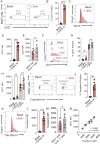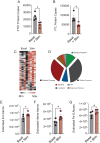Iron Is Critical for Mucosal-Associated Invariant T Cell Metabolism and Effector Functions
- PMID: 38619286
- PMCID: PMC11102027
- DOI: 10.4049/jimmunol.2300649
Iron Is Critical for Mucosal-Associated Invariant T Cell Metabolism and Effector Functions
Abstract
Mucosal-Associated Invariant T (MAIT) cells are a population of innate T cells that play a critical role in host protection against bacterial and viral pathogens. Upon activation, MAIT cells can rapidly respond via both TCR-dependent and -independent mechanisms, resulting in robust cytokine production. The metabolic and nutritional requirements for optimal MAIT cell effector responses are still emerging. Iron is an important micronutrient and is essential for cellular fitness, in particular cellular metabolism. Iron is also critical for many pathogenic microbes, including those that activate MAIT cells. However, iron has not been investigated with respect to MAIT cell metabolic or functional responses. In this study, we show that human MAIT cells require exogenous iron, transported via CD71 for optimal metabolic activity in MAIT cells, including their production of ATP. We demonstrate that restricting iron availability by either chelating environmental iron or blocking CD71 on MAIT cells results in impaired cytokine production and proliferation. These data collectively highlight the importance of a CD71-iron axis for human MAIT cell metabolism and functionality, an axis that may have implications in conditions where iron availability is limited.
Copyright © 2024 by The American Association of Immunologists, Inc.
Conflict of interest statement
The authors have no financial conflicts of interest.
Figures




References
-
- Godfrey, D. I., Koay H. F., McCluskey J., Gherardin N. A.. 2019. The biology and functional importance of MAIT cells. Nat. Immunol. 20: 1110–1128. - PubMed
-
- Le Bourhis, L., Martin E., Péguillet I., Guihot A., Froux N., Coré M., Lévy E., Dusseaux M., Meyssonnier V., Premel V., et al. . 2010. Antimicrobial activity of mucosal-associated invariant T cells. Nat. Immunol. 11: 701–708. - PubMed
-
- Treiner, E., Duban L., Bahram S., Radosavljevic M., Wanner V., Tilloy F., Affaticati P., Gilfillan S., Lantz O.. 2003. Selection of evolutionarily conserved mucosal-associated invariant T cells by MR1. Nature 422: 164–169. - PubMed
-
- Kjer-Nielsen, L., Patel O., Corbett A. J., Le Nours J., Meehan B., Liu L., Bhati M., Chen Z., Kostenko L., Reantragoon R., et al. . 2012. MR1 presents microbial vitamin B metabolites to MAIT cells. Nature 491: 717–723. - PubMed
MeSH terms
Substances
Grants and funding
LinkOut - more resources
Full Text Sources
Medical

